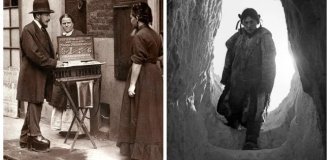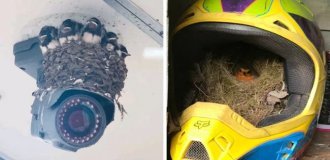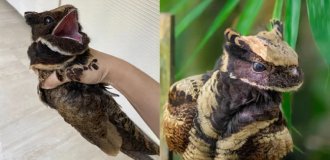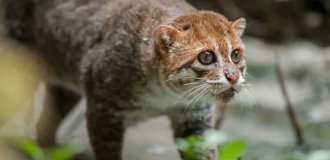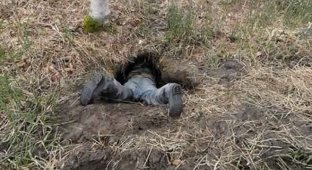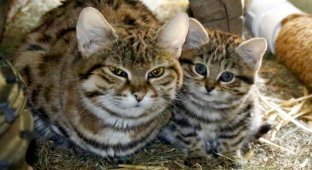Today I would like to talk about a bird that many have heard about, but few have seen.

A little biology
Hoodoo (lat. Upupa epops) is a small brightly colored bird with a long narrow beak and a crest, sometimes opening in the form of a fan. Widely distributed in the southern and central regions of Europe and Asia, as well as almost throughout Africa. The favorite habitat is open areas with sparse shrubs or trees, such as savanna, meadow or pasture. Also found in cultivated landscapes in orchards and vineyards. Cautious, but not timid - as a rule, it avoids people and flies away when they approach. Spends a lot of time on the ground, hunting insects.

According to the International Union for Conservation of Nature, the species is quite numerous. Despite the fact that the overall bird population has declined in recent years, its dynamics currently do not allow this species to be considered vulnerable. In the International Red Book, the hoopoe has the status of a taxon of minimal risk (category LC).
A small bird with a length of 25-29 cm and a wingspan of 44-48 cm. It is distinguished by the striped black and white plumage of the wings and tail, a long thin beak and a long crest on the head. It is one of the most easily recognizable birds. The color of the head, neck and chest, depending on the subspecies, varies from pinkish to chestnut. The wings are wide, rounded, painted with contrasting black and whitish-yellow stripes. The tail is medium length, black with a wide white band in the middle. The ventral part of the body is pinkish-red, with blackish longitudinal stripes on the sides. The crest on the head is orange-red, with black feather tips. Usually the crest is folded and has a length of 5-10 cm, (depending on the size of the bird), however, upon landing (rarely at other times), the bird spreads it, usually 10-15 cm high in a fan. The beak is 4-5 cm long, slightly curved down. The language, unlike many other bird species, is greatly reduced. The legs are lead-gray, quite strong, with short metatarsals and blunt claws. Males and females do not differ from each other in appearance. Young birds are generally colored in less saturated colors and have a shorter beak and crest.

when there is no way to escape, it can hide, clinging to the ground, spreading its wings and tail and raising its beak up.
The hoopoe's flight is slow, fluttering like a butterfly. However, it is quite maneuverable, and feathered predators rarely manage to grab a hoopoe in the air.
The hoopoe's vocalizations are as special as its appearance. The voice is a dull, slightly guttural three- to five-syllable cry “up-up-up” or “ud-ud-ud” (where it got its name), repeated several times in a row. The interval between series of sounds rarely exceeds 5 s. The bird's generic scientific name, Upupa, is an onomatopoeia of this unusual song (a phenomenon linguistically called onomatopoeia). In addition, when surprised or frightened, the hoopoe emits a piercing cry “chi-ir”, reminiscent of the cry of a ringed dove. Sometimes during mating games or when courting offspring it makes a dull, rolling sound.

The hoopoe is an Old World bird. In Eurasia, it is distributed throughout its entire length from west to east, in its middle and southern parts. In continental Asia outside of Russia, it lives almost everywhere, avoiding only deserts and areas of continuous forest. Found in the Japanese Islands, Taiwan and Sri Lanka. In Africa, the main range is located south of the Sahara, as well as in the far north along the Mediterranean coast. In Madagascar it lives in the western, drier part. In the mountains it is usually found up to 2000 m above sea level, although in some cases it rises to 3100 m.
Depending on the latitude, it is a sedentary, nomadic or migratory bird. The timing of migration is significantly extended in time - spring arrival occurs in early February - May with a peak in mid-March - April, autumn departure begins in mid-July and ends at the end of October. The flight takes place in a wide front, at night or at dawn.

The hoopoe reaches sexual maturity at the age of one year. Monogamous. In the middle zone, birds arrive at nesting sites quite early - in March-April, when the first thawed patches are just beginning to appear. Immediately upon arrival, the males occupy the breeding territory and behave very actively - they scream loudly, making repeated dull sounds “whoop-whoop-whoop...” and thereby calling the females. During this period, birds scream most often and loudly in the morning and evening, less often during the day. During courtship, the male and female slowly fly after each other, marking the site for the future nest. Often the same area is used for several years. As a rule, hoopoes breed in separate pairs, however, in the case of other hoopoes in the neighborhood, fights between males on the border of territories, reminiscent of cockfights, are not uncommon. The nest is made in a secluded place - a hollow tree, a rocky crevice, a depression on the slope of a cliff, sometimes in the wall of a stone or clay building. If there is no suitable shelter nearby, eggs may be laid directly on the ground among the dried remains of an animal. The lining is either completely absent or contains only a few blades of grass, feathers and pieces of cow dung. The hollow may also contain rotten wood dust. Breeding usually occurs once a year, although in the case of a sedentary lifestyle, repeated (up to three) cycles are noted. The clutch size in temperate climates consists of 5-9 eggs, in the tropics - 4-7 eggs. The eggs are oblong, 26×18 mm in size and weighing about 4.4 g. The color varies widely from grayish-white to dark brown, and may have a bluish or greenish tint. One egg is laid per day, incubation begins with the first egg and continues for 25-32 days (incubation period - 15-16 days). The female incubates alone, while the male provides food for her. The chicks that are born are blind and covered with sparse reddish down, which after a few days is replaced by another, pinkish-white and denser. Both parents feed the chicks, alternately bringing them insect larvae and worms. At the age of 20-27 days (in the middle zone - late June or early July), the chicks leave the nest and begin to fly, although they remain close to their parents for several more weeks.

The hoopoe's diet is based on small invertebrate animals: insects, their larvae and pupae (chafer beetles, dung beetles, carnivores, grasshoppers, butterflies, steppe fillies, flies, ants, termites), spiders, woodlice, millipedes, small mollusks, etc. Less often it catches small frogs, lizards and snakes.
It feeds on the surface of the ground, usually in short grass or on bare soil. Possessing a long beak, it often picks through manure, garbage heaps or rotten wood, and makes shallow holes in the ground. Often accompanied by grazing cattle. The hoopoe's tongue is short, so it is sometimes unable to swallow prey from the ground - to do this, the bird throws it into the air, catches it and swallows it. Large beetles are hammered on the ground, first broken into pieces.
The hoopoe is the only living species of bird belonging to the family Upupidae (another species, the giant hoopoe (Upupa antaios), lived on St. Helena, became extinct in the 16th century). Hoopoes belong to the order Bucerotiformes, which in addition to them includes 3 more families. Based on molecular studies (comparative DNA analysis), American biologists Charles Sibley and John Ahlquist hypothesized that the ancestors of hoopoes are hornbills, and forest hoopoes descended from the hoopoe. There are usually 10 subspecies of hoopoe described based on size, color tones and wing shape. Some authors, such as James Clemens in the reference book “Birds of the World: A Checklist”, based on the works of Sibley and Ahlquist, identify the African hoopoe (U. e. africana) as a separate species.

Interesting Facts:
- The Bible and the Koran mention the hoopoe... And among the birds you should abhor these (you must not eat them, they are unclean): the eagle, the vulture and the sea eagle, the kite and the falcon with its kind, every raven with its kind, the ostrich, the owl, the seagull and a hawk with its kind, an eagle owl, a fisherman and an ibis, a swan, a pelican and a vulture, a heron, a zooya with its kind, a hoopoe and a bat. (Tanakh, Torah, Leviticus, Chapter 11:13-19)
In the Koran, Suleiman (Solomon) Examining the birds, he said: “What is wrong with me? Why don't I see the hoopoe (Arabic, al-hudhuda)? Or was he (among) those hiding? I will subject him to severe torture, or I will kill him if he does not make an obvious argument.” (Surah 27:20-21). Hoopoe meat is not kosher for Jews, but haram for Muslims.
- In ancient Greek mythology, according to the works of the ancient classics, the Thracian king Tereus, the son of the god of war Ares and the Biston nymph, was turned into a hoopoe after he tried to kill his wives
- Among the Ingush and Chechens during pagan times, the hoopoe (“tushol-kotam”) was considered a sacred bird and symbolized the goddess of spring, fertility and childbirth Tusholi. It was possible to kill a hoopoe only with the permission of the priest for ritual purposes, and its nest in the yard was considered a good omen. By the way, one of the crowns (ring structures) on Venus is named after the goddess.

- In the work of the great Persian Sufi poet Faridaddin Attar, “The Parliament of Birds,” the hoopoe symbolizes the leader of humanity, inviting the birds to go on a long-distance search for their mysterious King Simurgh, who lives on Mount Kaf.
- In terms of vocalization, the Madagascar subspecies stands somewhat apart - its voice is more reminiscent of a booming purr.
- Despite this, even at the end of the 19th century in Germany, they ate the meat of adult hoopoes and chicks and found it “very tasty.”
- In May 2008, in connection with the 60th anniversary of Israel, at the initiative of the Ministry of Environment, elections were announced for the national bird of this state. As a result of the vote, in which all residents of the country could take part, the hoopoe was chosen - more than 35% voted in favor of this bird, leaving far behind the warbler, goldfinch, short-toed song thrush and some other birds.
- As already mentioned above, a hoopoe can make nests in the remains of animals, the famous German and Russian scientist Peter Pallas described a hoopoe nest in the chest of a human skeleton.
- There was also a folk sign: if the peasants thought that the hoopoe was shouting “It’s bad here!”, the harvest would be bad, but if they heard the cry “I’ll be here!”, then they expected a rich harvest. In the south of Russia and Ukraine, it was believed that the cry of a hoopoe foreshadows rain, hence another name for it in Ukrainian dialects – slotnyak, from the word slot “bad weather”. In some regions of Ukraine, the hoopoe was called “sinokos”, since it was believed that it screams on the eve of haymaking time.

- In Poland they said that Jews brought hoopoe with them from other countries, and also that it screams in Hebrew. In the Lvov region it was believed that the hoopoe pronounces the name of the Jews: “Yud-yud!”, and near Brest in the cry of the hoopoe they heard “Vus-vus-vus?” - “What-what-what?” in Yiddish.
- An interesting fact is the breeding and reproduction of birds. It is known that the female lays 5-9 eggs in one period, depending on the chosen territory. However, she lays no more than one egg per day, which does not prevent her from starting hatching from the first day. Incubation is carried out only by the female, and at this time the male is looking for food for his female.
- In Dahl's explanatory dictionary, hoopoe was called a dummy and a tattoo.
- During the period of incubation and feeding of chicks, adult birds and chicks produce an oily liquid secreted from the coccygeal gland and having a sharp, unpleasant odor. By releasing it along with droppings onto an alien, hoopoes try to protect themselves from small terrestrial predators - as a result of this adaptation, in the eyes of humans, the bird has acquired a reputation as a very “unclean” creature.
- . Unlike the vast majority of birds, hoopoes never remove droppings from the nest, which gradually accumulates around.

- The most ancient group of birds similar to modern hoopoes is considered to be the extinct family Messelirrisoridae (sister to Upupidae and Phoeniculidae), whose representatives dominated Europe in the Middle Eocene about 49 million years ago.
- An image of a bright bird can be found on Gambian banknotes (50 dalasis).
- The hoopoe’s tongue is shorter than its beak, so the bird cannot always immediately swallow prey grabbed by the tip of its beak. You have to practice juggling - throwing food up and catching it with an open beak.

- They defend themselves from enemies in the manner of a skunk: the coccygeal gland in chicks and the brooding female secretes a strong and foul-smelling oily liquid.
- Hoopoes scare enemies by hugging the ground with outstretched wings and raised beak. They then look like something unimaginable and incomprehensible and therefore terrible.
- In slang, hoopoe is a person out of his mind, inadequate, bad to the point of madness.
- Hoopoe, was chosen as the bird of 2016 in Russia. This is one of the most colorful and memorable birds in the country.
- In the female during the breeding season and in the chicks, the coccygeal gland secretes a black sticky mass with the smell of rotten meat. During nesting time, both adult birds, chicks and their homes are smeared with it. Microbiologists discovered a bacterium in it - fecal enterococcus, which produces antibiotics that kill other bacteria. They are effective against Staphylococcus aureus, which is dangerous to birds and people, as well as against bacteria that destroy feathers.
- The 94th Mechanized Infantry Battalion of the Israel Defense Forces is called 'Duhifat', which means 'hoopoe' in Hebrew.

- Our children get acquainted with the hoopoe at a very early age. This happens thanks to the poem by Samuil Yakovlevich Marshak “The Intractable Hoopoe” (a retelling of a Czech folk song). Well, who among us doesn’t remember:
“Marina was walking from the garden,
I found a hoopoe under a bush.
And the hoopoe said to her: “Doo-doo-doo,”
I won't live with you!
I'll run away to my old grandmother,
Grandma will give me some cottage cheese!”
- In the Brothers Grimm’s fairy tale “The Bittern and the Hoopoe,” our bird again does not shine with intelligence, since the Hoopoe “grazed his herd along high, dry mountain slopes, where the wind twists the sand, and his cows were thin and could not gain strength.”
- one of the legends of Crimea tells about Mount Opuk - the mountain of two hoopoes.
- The hoopoe is a natural non-heraldic figure. The hoopoe is a symbol of sinfulness and sadness. Rarely used in heraldry. Mainly found in territorial heraldry.
- Bird of the year 2013 in Belarus - Hoopoe
- The hoopoe was highly valued in Ancient Egypt. There is even a known hieroglyph depicting the head of a hoopoe with a raised crest on the crown.
- In the summer months, the hoopoe was seen far to the north, even in Iceland. However, this bird cannot nest in such cold areas.
As usual, for those who are too lazy to read
A few more photos













